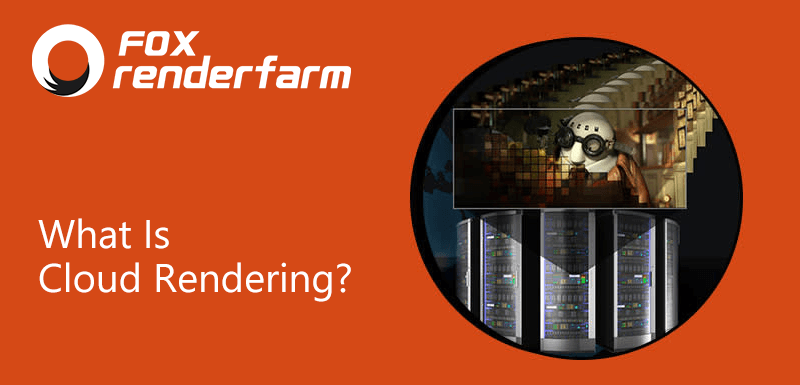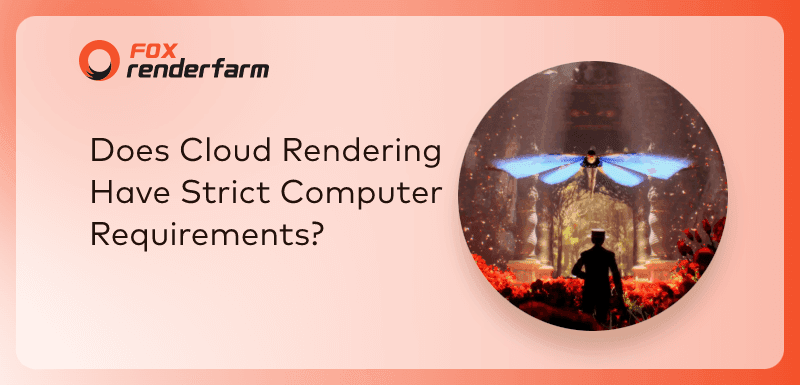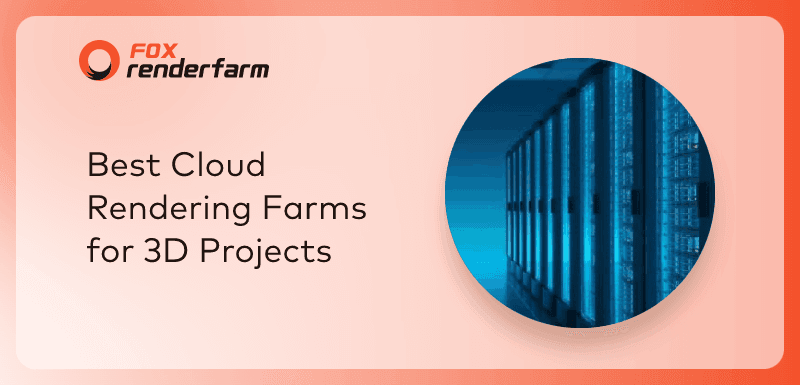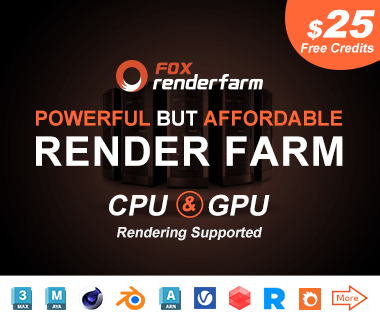What is Rendering on the Cloud?

Rendering is the backbone of creative industries like animation, architecture, gaming, and film. It’s the process that transforms raw 3D models into stunning, lifelike images or animations. Traditionally, rendering has been a resource-heavy task, requiring expensive hardware and endless patience. But now, rendering on the cloud has changed the game entirely, offering speed, scalability, and accessibility that local systems can’t compete with.
In this guide, we’ll explore what cloud rendering is, how it works, its benefits, challenges, and why platforms like Fox Renderfarm are at the forefront of this technological revolution.
What is Rendering on the Cloud?
Rendering on the cloud, aka cloud rendering, refers to outsourcing the computationally intensive rendering process to remote servers in cloud data centers. Instead of straining local hardware, creatives can rely on powerful cloud infrastructure to handle complex rendering tasks.
Why it Matters?
Traditional rendering setups demand:
- High-performance hardware.
- Significant investment in upgrades.
- Long wait times for large projects.
Cloud rendering eliminates these bottlenecks by providing a pay-as-you-go service that scales with your needs. As Fox Renderfarm puts it, "Cloud rendering empowers creators to focus on their craft without being constrained by hardware limitations."
How Does Rendering on the Cloud Work?
Let’s break down the process of cloud rendering:
Step-by-Step Workflow
- Upload Assets: Your project files, including models, textures, and settings, are uploaded to a cloud-rendering platform like Fox Renderfarm.
- Configure Settings: Choose your rendering options—resolution, frame rate, and desired output.
- Processing: The platform’s servers get to work after analysis, distributing the rendering load across multiple machines for maximum efficiency.
- Download Results: Once rendering is complete, you can download your finished project files.
Key Components
|
Component |
Purpose |
|
Cloud Servers |
Perform rendering tasks using high-speed processors and GPUs. |
|
Rendering Software |
Industry-standard tools like Blender, Maya, and Arnold. |
|
Storage |
Securely store project files before and after rendering. |
This seamless workflow lets creators focus on their projects instead of worrying about technical constraints.
Benefits of Rendering on the Cloud
The advantages of cloud rendering are game-changing, especially for small studios and individual creators:
1. Faster Turnaround Times
Cloud rendering distributes workloads across multiple servers, drastically reducing rendering time. For instance, what might take days on a local machine can be completed in hours or even minutes.
2. Scalability
Whether you’re working on a small personal project or a blockbuster movie, cloud rendering scales with your needs. You can render one frame or thousands without worrying about hardware limitations.
3. Global Accessibility
Cloud rendering platforms allow you to work from anywhere in the world. Teams can collaborate remotely, uploading and downloading assets as needed.
Challenges of Rendering on the Cloud
While cloud rendering offers incredible benefits, it’s important to acknowledge its challenges:
1. Internet Dependency
Rendering on the cloud requires stable and fast internet for uploading assets and downloading results. A weak connection can slow down the workflow.
2. Data Security Concerns
Uploading sensitive project files to a cloud platform can raise security issues. However, platforms like Fox Renderfarm address this with encryption and secure data centers.
3. Cost Management
Without careful oversight, costs can add up, especially for large-scale projects. Fox Renderfarm mitigates this by offering usage analytics and flexible pricing.
How to Overcome These Challenges
- Use a reliable internet connection with a backup option.
- Encrypt sensitive data before uploading.
- Monitor your usage to stay within budget.
Industries Benefiting from Cloud Rendering
Cloud rendering is a game-changer across various fields:
|
Industry |
Use Case |
|
Animation & Film |
Rendering high-quality visuals for movies and TV shows. |
|
Architecture |
Creating photorealistic 3D models and walkthroughs for client presentations. |
|
Gaming |
Building detailed environments and characters for immersive experiences. |
|
Marketing |
Designing captivating visuals for advertising campaigns. |
Future of Cloud Rendering
The future of cloud-based rendering looks promising, with advancements that will make the process even more efficient and accessible:
Emerging Trends
- AI Rendering: Automating repetitive tasks to enhance speed and quality.
- Real-Time Rendering: Enabling instant feedback for gaming and virtual reality projects.
- Hybrid Models: Combining local and cloud resources for optimal performance.
As the demand for high-quality visuals grows, platforms like Fox Renderfarm will continue to lead the charge in innovation.
Fox Renderfarm: A Leader in Cloud Rendering

When it comes to cloud-based rendering, Fox Renderfarm is a trusted name in the industry. It’s renowned for its reliability, speed, and user-friendly features.
Why Choose Fox Renderfarm?
- Extensive Software Support: Fox Renderfarm is compatible with a wide range of popular 3D software and rendering engines, including Blender, Maya, 3ds Max, Cinema 4D, and Unreal Engine.
- Powerful Infrastructure: The platform offers both CPU and GPU rendering services, utilizing thousands of rendering nodes to ensure efficient and high-quality rendering.
- User-Friendly Interface: Fox Renderfarm provides an intuitive interface that simplifies the process of uploading projects, monitoring progress, and downloading completed renders.
- Security and Privacy: As a TPN-accredited vendor, Fox Renderfarm adheres to strict security standards to protect user data and project assets.
Fox Renderfarm’s dedication to quality is summed up perfectly: "With networked access and superior processing functions, users can harness top-level graphics processing capabilities, enabling seamless graphics applications across devices once rendering tasks are complete."
Conclusion: Why Rendering on the Cloud is the Future
Rendering on the cloud has revolutionized the way we create, offering speed, scalability, and cost-efficiency that traditional methods simply can’t match. Platforms like Fox Renderfarm have made this technology accessible to all, from solo creators to large studios.
Whether you’re working on an indie film, designing architectural marvels, or creating the next big video game, cloud rendering can transform your workflow. With a powerful render farm's robust features, you can focus on what truly matters—your creativity.
Ready to experience the future of rendering? Sign up with Fox Renderfarm to get a free $25 render coupon today and take your projects to the next level!
Recommended reading
Top 9 Best And Free Blender Render Farms of 2025
2024-12-30
Revealing the Techniques Behind the Production of Jibaro "Love, Death & Robots", Which Took Two Years to Draw the Storyboard
2025-02-10
Top 10 Free And Best Cloud Rendering Services in 2025
2025-03-03
Top 8 After Effects Render Farm Recommended of 2025
2025-02-10
Top 5 Best and Free 3d Rendering Software 2025
2025-02-10
Shocked! The Secret Behind Using 3D to Make 2D Animation was Revealed!
2025-02-10
How to Render High-quality Images in Blender
2024-12-04
Easy Cel Shading Tutorial for Cartoon in Blender Within 2 Minutes
2025-02-10
Partners
Previous: Wie beschleunigt man das Cinema 4D Rendering?
Next: What Render Farm Should I Use for Architectural Visualization?
Interested






